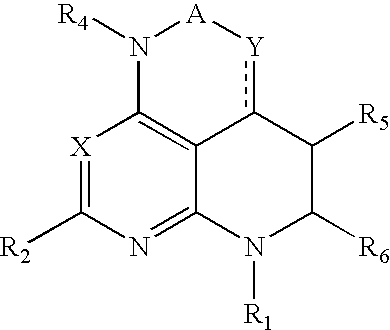Tri-and tetraaza-acenaphthylen derivatives as CRF receptor antagonists
a technology of acenaphthylen and derivatives, which is applied in the field can solve the problems of lack of stability, limited oral activity, and suffers of peptide crf receptor antagonists
- Summary
- Abstract
- Description
- Claims
- Application Information
AI Technical Summary
Benefits of technology
Problems solved by technology
Method used
Image
Examples
example 1
Synthesis of Representative Pyridine Intermediate
[0118]
Compound 2
[0119]Chloropyridine 1 is dissolved in THF and added to a stirred suspension of LAH in THF at −78° C. The mixture is stirred for 6 hours at this temperature and for 1 hour at −30° C. The mixture is then treated cautiously with water, 15% aqueous NaOH and water with vigorous stiring. The mixture is warmed to room temperature and filtered. The white precipitate is washed liberally with ethyl acetate. The combined organic portions are dried (MgSO4) and concentrated under vacuum. Purification via flash chromatography gives the desired 2.
Compound 3
[0120]DMSO (6 equivalents) is added to a stirred solution of oxalyl chloride (3 equivalents) in dichloromethane at −70° C. After 15 min, alcohol 2 (1 equivalent) in dichloromethane is added, followed by triethylamine. The mixture is allowed to warm to room temperature and stirred for 1 hour. The mixture is washed with aqueous sodium bicarbonate (75 mL), dried (MgSO4), and concentr...
example 2
Synthesis of Representative Pyrimidine Intermediate
[0122]
Compound 2
[0123]The chloropyrimidine 1 is dissolved in THF and added to a stirred suspension of LAH in THF at −78° C. The mixture is stirred or 6 hours at this temperature and for 1 hour at −30° C. The mixture is then treated cautiously with water, 15% aqueous NaOH and water with vigorous stirring. The mixture is warmed to room temperature and filtered. The white precipitate is washed liberally with ethyl acetate. The combined organic portions are dried (MgSO4) and concentrated under vacuum. Purification via flash chromatography gives the desired product 2.
Compound 3
[0124]DMSO (6 equivalents) is added to a stirred solution of oxalyl chloride (3 equivalents) in dichloromethane at −70° C. After 15 min, alcohol 2 (1 equivalent) in dichloromethane is added, followed by triethylamine. The mixture is allowed to warm to room temperature and stirred for 1 hour. The mixture is washed with aqueous sodium bicarbonate (75 mL), dried (MgSO...
example 3
Synthesis of Representative Compounds of Structure (1)
[0126]
Compound 2:
[0127]The enone 1 (compound 4 from examples 1 and 2 above, 4.26 mmol), R1NH2 (4.3 mmol) and toluenesulfonic acid monohydrate (4.3 mmol) in ethanol (20 mL) are heated at 60° C. for 16 hours. The mixture is concentrated, taken up in ethyl acetate (50 mL), washed with aq. NaHCO3 (20 mL), dried (MgSO4) and concentrated under vacuum. The residue is purified on a silica gel column (elution with 25% ethyl acetate in hexanes) to afford 2.
Compound 4:
[0128]LDA in THF (0.325M, 0.83 mL, 0.27 mmol) is added to a stirred solution of the phosphine oxide (66 mg, 0.27 mmol) in THF (2 mL) at −25° C. After 15 minutes, compound 2 (11 mg, 0.034 mmol) in THF (1 mL) is added and the mixture is stirred for 15 min. NaH (30 mg) is added, the mixture is warmed to room temperature and stirred for 16 hours. The mixture is diluted with water (15 mL) and extracted with EtOAc (4×10 mL). The combined extracts are dried (MgSO4), concentrated in v...
PUM
| Property | Measurement | Unit |
|---|---|---|
| Electrical conductance | aaaaa | aaaaa |
| Electrical conductance | aaaaa | aaaaa |
| Electrical conductance | aaaaa | aaaaa |
Abstract
Description
Claims
Application Information
 Login to View More
Login to View More - R&D
- Intellectual Property
- Life Sciences
- Materials
- Tech Scout
- Unparalleled Data Quality
- Higher Quality Content
- 60% Fewer Hallucinations
Browse by: Latest US Patents, China's latest patents, Technical Efficacy Thesaurus, Application Domain, Technology Topic, Popular Technical Reports.
© 2025 PatSnap. All rights reserved.Legal|Privacy policy|Modern Slavery Act Transparency Statement|Sitemap|About US| Contact US: help@patsnap.com



